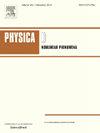Four-equation model for unified prediction of turbulent mixing induced by interfacial instabilities
IF 2.9
3区 数学
Q1 MATHEMATICS, APPLIED
引用次数: 0
Abstract
Turbulent mixing induced by interfacial instabilities are generally predicted using the Reynolds-averaged Navier–Stokes (RANS) model in practical applications. Among RANS models, the advanced Besnard–Harlow–Rauenzahn (BHR) series stand out due to its capacity to characterize the mixing state, which is quite important for reaction rate calculation in fusion engineering. However, the present limitation of this model is its inability to unified predict mixing growth rates and profiles across diverse density ratios or types of turbulent mixing scenarios. To overcome these limitations, we extend the methodology in determining turbulence model coefficients to the four-equation framework. The extension concerns a refined four-equation model, particularly in modifying the dissipation term associated with the density-specific volume covariance, thereby greatly improving the model’s performance at high density ratios. Further, new self-similar profiles for various physical quantities are introduced by considering more realistic evolution. This enhancement is shown to yield more plausible predictions. Finally, leveraging the unique traits of the four-equation model, we utilize an ansatz of self-similarity to derive consistent model coefficients ensemble tailored to different turbulent mixing scenarios. With these enhancements, this model realizes unified predictions of mixing width and profiles across classical turbulent mixings and complex mixings, agreeing well with high-fidelity numerical simulations and experimental measurements. Given the model’s descriptive prowess of mixing state characteristics pertinent to engineering challenges, it has significant potential in the precise prediction of fusion reaction rate and assessments of fusion performance.
界面不稳定引起的湍流混合统一预测的四方程模型
在实际应用中,通常使用reynolds -average Navier-Stokes (RANS)模型来预测由界面不稳定性引起的湍流混合。在RANS模型中,先进的Besnard-Harlow-Rauenzahn (BHR)系列因其能够表征混合状态而脱颖而出,这对于核聚变工程中的反应速率计算非常重要。然而,该模型目前的局限性在于它无法统一预测不同密度比或不同类型湍流混合场景下的混合增长率和混合曲线。为了克服这些限制,我们将确定湍流模型系数的方法扩展到四方程框架。该扩展涉及一个改进的四方程模型,特别是修改了与密度比体积协方差相关的耗散项,从而大大提高了模型在高密度比下的性能。此外,通过考虑更现实的演化,引入了各种物理量的新的自相似曲线。这种增强被证明可以产生更可信的预测。最后,利用四方程模型的独特特征,我们利用自相似的ansatz来获得适合不同湍流混合场景的一致模型系数集合。通过这些改进,该模型实现了跨经典湍流混合和复杂混合的混合宽度和剖面的统一预测,与高保真的数值模拟和实验测量结果很好地吻合。鉴于该模型对与工程挑战相关的混合状态特征的描述能力,它在精确预测聚变反应速率和评估聚变性能方面具有重大潜力。
本文章由计算机程序翻译,如有差异,请以英文原文为准。
求助全文
约1分钟内获得全文
求助全文
来源期刊

Physica D: Nonlinear Phenomena
物理-物理:数学物理
CiteScore
7.30
自引率
7.50%
发文量
213
审稿时长
65 days
期刊介绍:
Physica D (Nonlinear Phenomena) publishes research and review articles reporting on experimental and theoretical works, techniques and ideas that advance the understanding of nonlinear phenomena. Topics encompass wave motion in physical, chemical and biological systems; physical or biological phenomena governed by nonlinear field equations, including hydrodynamics and turbulence; pattern formation and cooperative phenomena; instability, bifurcations, chaos, and space-time disorder; integrable/Hamiltonian systems; asymptotic analysis and, more generally, mathematical methods for nonlinear systems.
 求助内容:
求助内容: 应助结果提醒方式:
应助结果提醒方式:


